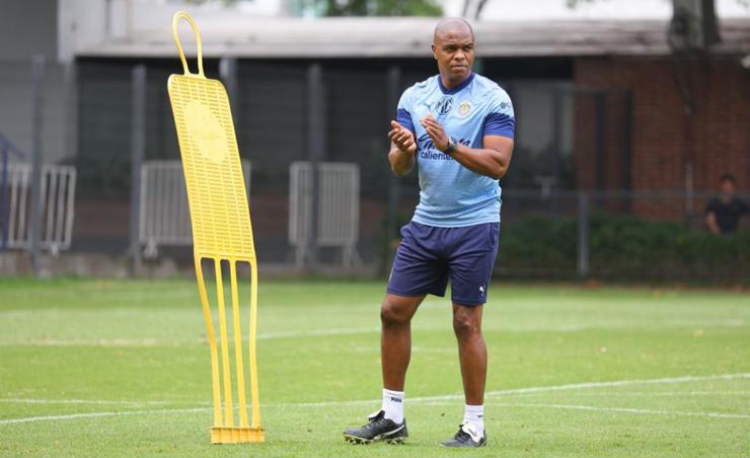You are viewing 1 of your 1 free articles
Overload with a switch of play
It is always interesting to understand how coaches think about exploiting the opposition’s system of play. This is a session that I would use when we are due to be playing against opponents expected to set up in a 3-5-2 formation. We would look to isolate the outside centre backs and switch the play, while overloading on the sides.
| Area | Up to full pitch |
| Equipment | Balls, bibs, cones, poles, mannequins, 2 goals |
| No. of Players | Up to 20 players + 2 goalkeepers |
| Session Time |
Switch of play passing drill: 10mins, Possession with a switch: 15mins, Functional play: 10mins, 10v10 game: 15mins, 11v11 game: 10mins |
It is always interesting to understand how coaches think about exploiting the opposition’s system of play. This is a session that I would use when we are due to be playing against opponents expected to set up in a 3-5-2 formation. We would look to isolate the outside centre backs and switch the play, while overloading on the sides.
Engaging our players in the tactical aspect of how we are going to win a game is very important and this is a session that fulfils that objective, building up through a series of activities and culminating in a final 11v11 game.
This would be the kind of technical and slightly physical session that we would choose to run on match day -2, when playing against opponents utilising a 3-5-2 formation.
SWITCH OF PLAY PASSING DRILL
We would use this passing drill when we are looking to get a switch of play into our style of play.
We set up in an area of 20x16 yards with a cone near each corner and a flag on each side at the halfway point as shown. We’re using 16 outfield players, with four players waiting on each cone.
The ball starts with player A who passes long to player B. Player B takes two touches – one to control and one to lay the ball back to player A who receives on the move, as shown [1a]. Player B then makes a well-timed run to the flag on the far side of the playing area, which is used as an offside line. After receiving on the move, player A passes to player C and runs to the back of the group in front. Player C, who started as the second man in the line, then makes a switch of play to player B who is now at the flag on the halfway line. Player B receives and dribbles to the back of the group. Player C is now at the front of his group and becomes the new player B, ready to receive the next long pass from the new starting player A.
1a
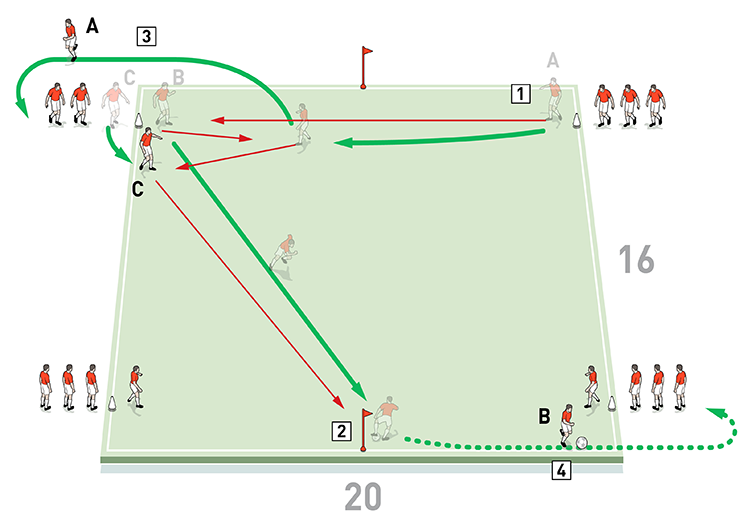
2. Player B makes a run to the flag on the other side of the area
3. Player A passes to C, who switches play to B who is now at the flag on the opposite side. Player A then joins the back of the queue
4. Player B receives from C and dribbles to the back of the queue. The drill is then repeated
Two balls would be running in the playing area at the same time, with the second ball mirroring the movement of the other group, as shown [1b].
1b
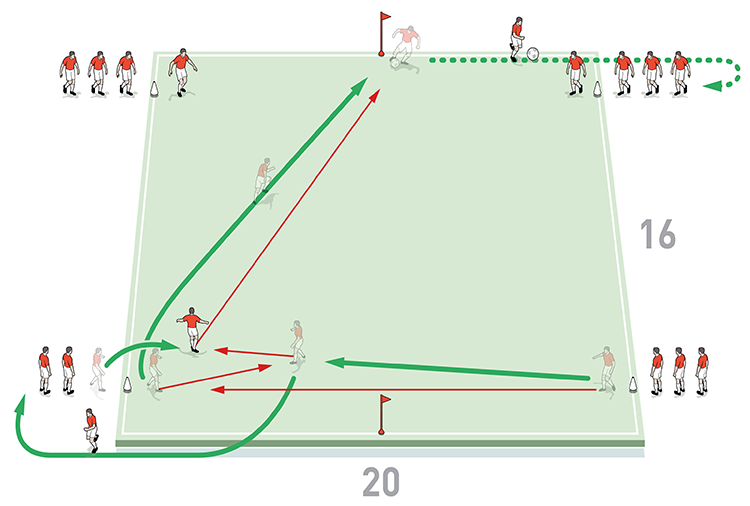
We work on passing with both feet by switching the groups. The size of area would be varied over the 10-minute drill.
POSSESSION WITH A SWITCH
We set up in a 40x40-yard square with a cone at the halfway point of each side. We’re using 20 outfield players, split evenly into two teams of ten. Each team has four players around the outside (one on each side) and five players in the centre.
Plays starts with a pass into the area from the coach to one of the teams and they must pass the ball, keeping possession under pressure. Inside the square players are three-touch but on the outside the players are only allowed one touch.
Players can use their team mates on the outside to keep possession and in addition to playing bounce passes to the central players, the outside players can make also make a diagonal switch of play to a team mate on the next side, or switch the play across the square to the opposite side.
The aim is to suck the pressing team in to create space for a switch of play across the square. A point is scored by switching play from one side of the square to a team mate on another side, as shown [2]. If the pressing team wins the ball, they become the passing team.
2
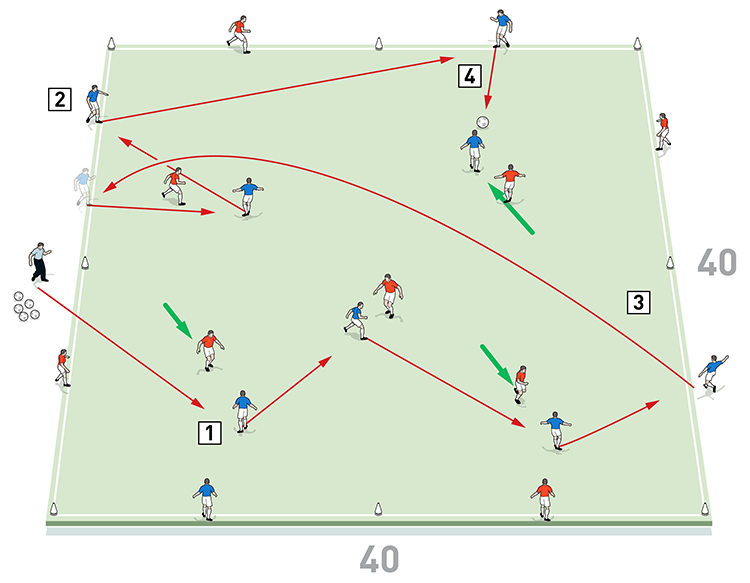
2. Players can use team mates on the outside to keep possession. Outside players are one-touch
3. The aim is to create space for a switch of play, which scores a point
4. Teams can score an extra point if they string eight passes together, as here
To add some physical work to the exercise, we allow players to score an extra point if they string a target number of passes together, say eight passes. This helps give the exercise a more competitive edge.
We play five games of three minutes with players rotating roles.
FUNCTIONAL PLAY DRILLS
We set up on half a pitch with a goal and a goalkeeper at one end of the pitch and we position eight mannequins to represent opponents, as shown.
We are using eight outfield players in this drill, all on the attacking team – although we could use live opposition instead of mannequins if it was felt to be necessary.
We would run the three drills, as shown [3a/b/c], with play starting with a long pass out from the opposition goalkeeper each time. This would allow our players to continue rehearsing options for finding the switch of play and it would help their decision making in the event of finding themselves in a position to execute the switch of play in a live match.
3a

2. The left back controls and plays the ball back to the midfielder, who switches the play to the right-sided attacker
3. The right back makes an overlapping run up the wing
3b
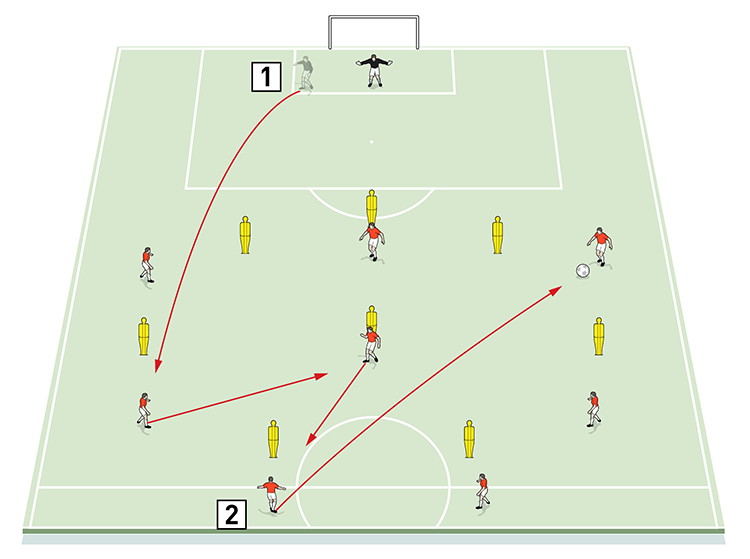
2. Two midfielders combine and one of them switches the play to the right-sided attacker
3c
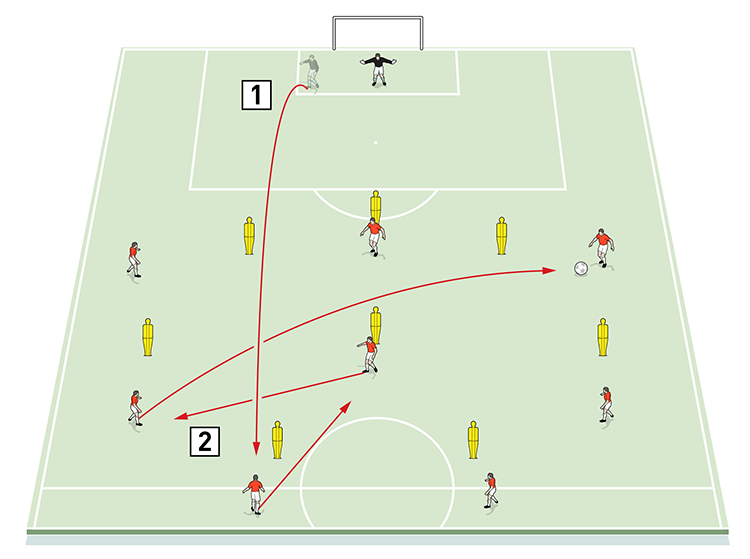
2. Two midfielders combine to pass to the left back, who switches play to the right-sided attacker
10v10 GAME
We set up on half a pitch with a goal and a goalkeeper at each end. We’re using 18 outfield players split evenly into two teams.
We coach the team set up in a partial 4-2-1-3 formation against an opposition playing in a partial 3-5-2 system, as shown [4].
4

2. Player movement off the ball creates the space to enable a switch of play
3. The opposition are set-up in a partial 3-5-2 system
We would work on player movement off the ball to gain space to enable a switch of play. We would try to get our team to isolate the opposition’s outside centre backs in a 1v1 situation and run at them with pace. We would try to get an overload against the back three.
We would play this game for 20 minutes.
11v11 GAME
We would finish this training session by progressing into a 11v11 match. We set up on a full pitch with a goal and a goalkeeper at each end.
We’re using 20 outfield players split evenly into two teams. We coach the team set up in a 4-2-1-3 formation against a team playing in a 3-5-2 formation, as shown [5].
5
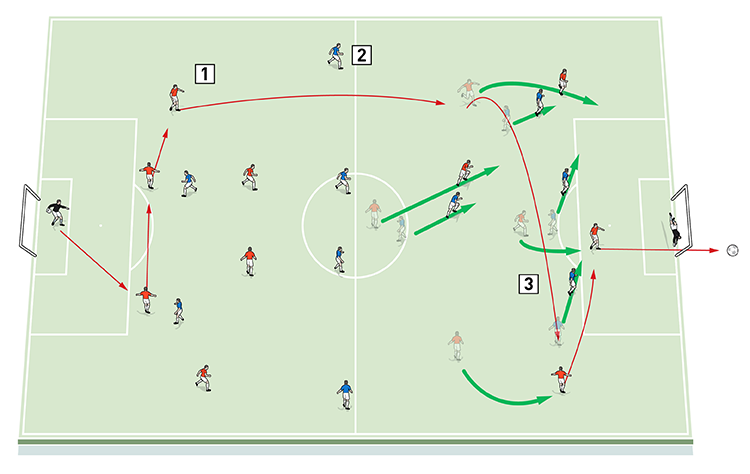
2. The opposition are set-up in a 3-5-2 system
3. The attacking team works on using switches of play to create overloads against the defence and to set up scoring opportunities
We would work on the various elements of play to gain an overload and create a switch of play.
We would play this game for 30 minutes.
Related Files
Editor's Picks
Intensive boxes drill with goals
Penetrating the final third
Creating and finishing
My philosophy
Pressing initiation
Compact team movement
Defensive organisation
Back three tactics
Counter-pressing as an offensive weapon
Coaches' Testimonials

Alan Pardew

Arsène Wenger

Brendan Rodgers

Carlos Carvalhal
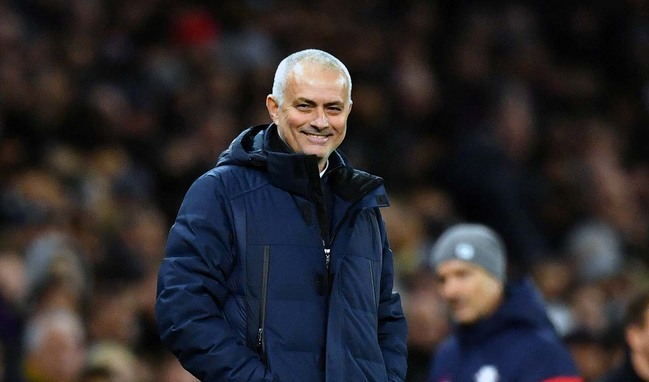
José Mourinho

Jürgen Klopp

Pep Guardiola

Roy Hodgson

Sir Alex Ferguson

Steven Gerrard
Coaches' Testimonials

Gerald Kearney, Downtown Las Vegas Soccer Club

Paul Butler, Florida, USA

Rick Shields, Springboro, USA

Tony Green, Pierrefonds Titans, Quebec, Canada
Join the world's leading coaches and managers and discover for yourself one of the best kept secrets in coaching. No other training tool on the planet is written or read by the calibre of names you’ll find in Elite Soccer.
In a recent survey 92% of subscribers said Elite Soccer makes them more confident, 89% said it makes them a more effective coach and 91% said it makes them more inspired.
Get Monthly Inspiration
All the latest techniques and approaches
Since 2010 Elite Soccer has given subscribers exclusive insight into the training ground practices of the world’s best coaches. Published in partnership with the League Managers Association we have unparalleled access to the leading lights in the English leagues, as well as a host of international managers.
Elite Soccer exclusively features sessions written by the coaches themselves. There are no observed sessions and no sessions “in the style of”, just first-hand advice delivered direct to you from the coach.








